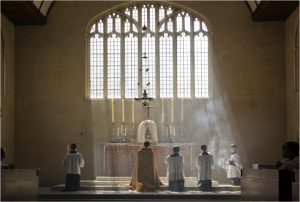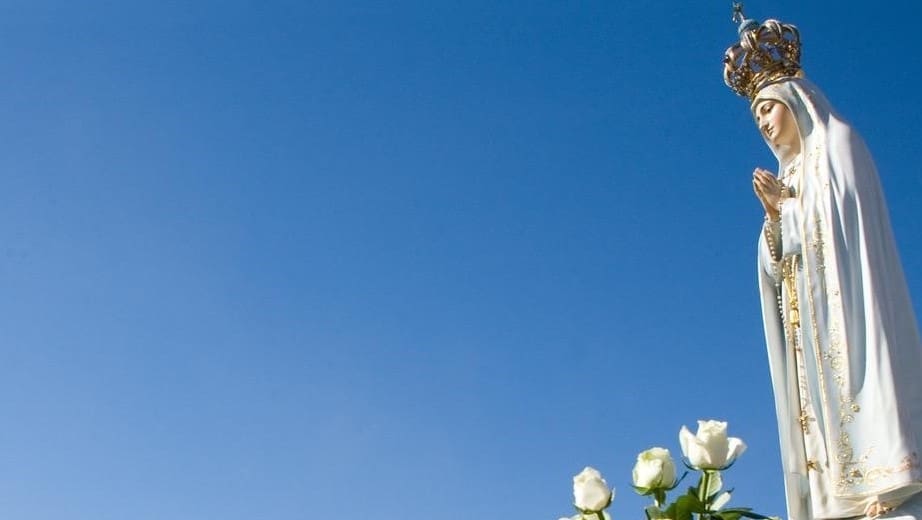The Latin Church is often accused of giving scant attention to the Holy Spirit. You can decide for yourself whether the caricature is accurate—for the Western Church as a whole, or for yourself as a member of it. (By way of a simple test, ask yourself: to whom do you address your prayers? To “God”? To the Father? To Jesus? or—last but not least—to the Holy Spirit?)
Whether it’s true or not that we bump the Holy Spirit to the back of the prayer train, the present Easter Season is the right time to invite the Holy Spirit into our hearts to “enkindle in them the fire of his love.” At the same time, we might reflect upon (and thereby simply reflect) the liturgical reality of the Holy Spirit made present to us in signs and symbols.

The Person of the Holy Spirit is foreshadowed—his Light casting an anticipatory shadow in the persons and events of the Old Covenant—in many ways among the chosen people, as well as at Christ’s coming. Among the most prominent of the figures and images are cloud and light.
“In the theophanies of the Old Testament,” explains the Catechism of the Catholic Church, “the cloud, now obscure, now luminous, reveals the living and saving God, while veiling the transcendence of his glory—with Moses on Mount Sinai, at the tent of meeting, and during the wandering in the desert…. In the Holy Spirit, Christ fulfills these figures. The Spirit comes upon the Virgin Mary and ‘overshadows’ her, so that she might conceive and give birth to Jesus. On the mountain of Transfiguration, the Spirit in the ‘cloud came and overshadowed’ Jesus, Moses and Elijah, Peter, James and John, and ‘a voice came out of the cloud, saying, This is my Son, my Chosen; listen to him!’ Finally, the cloud took Jesus out of the sight of the disciples on the day of his ascension and will reveal him as Son of man in glory on the day of his final coming” (697).
“Luminous clouds” also appear in the sacred liturgy. Did you notice, for example, that our procession out of Holy Saturday’s darkness and into the church was led by cloud and light, with the smoking thurible (its coals taken from the Easter fire) leading the Paschal Candle toward the sanctuary?
Later, at the blessing of the font, the Holy Spirit descends upon the font at the epiclesis—“May the power of the Holy Spirit, O Lord, we pray, come down through your Son into the fullness of this font”—in the form of the Paschal Candle. That is, in the same way that the Holy Spirit “overshadowed” the Blessed Virgin Mary at the Christ’s conception, so now does he, as Light, overshadow the font, the womb of the Church, at the conception of new Christians.
Another oft-heard and oft-misunderstood reference to the Holy Spirit comes at the epiclesis over the bread and wine in the Second Eucharistic Prayer: “Make holy, therefore, these gifts, we pray, by sending down your Spirit upon them like the dewfall.” As the Chosen People crossed the desert on their journey to the Promised Land, they complained for want of food and sustenance. While Aaron addressed their complaints, they saw a “glorious cloud” that would shortly whet their appetites even more.
“In the evening,” the Book of Exodus recounts, “quail came up and covered the camp. In the morning there was a layer of dew all about the camp, and when the layer of dew evaporated, fine flakes were on the surface of the wilderness, fine flakes like hoarfrost on the ground” (16:13-14).
And now here we are: pilgrims on a journey to the Promised Land of heaven, often grumbling and complaining, unsatisfied. At our vexatious worst, though, God sends down a luminous cloud “like the dewfall.” And what remains is manna from heaven to satisfy our hunger and sustain us on our journey.
These are just a few occasions of the Holy Spirit’s sacramental presence to us in the Roman liturgy. Still, our encounter with him can be more dark than luminous, either because incense (for example) is rarely or never used, or because those who see or smell it don’t know the reality incense contains.
Clouds, shadows, dew, smoke, rain, wind are just some of the ways that the Holy Spirit has touched the lives of the faithful in the time of promises. This same Spirit wishes to enliven us today through the splendent sacramental signs of the liturgy.
In a similar way, our present issue of the Adoremus Bulletin can help clarify our liturgical minds. In this issue, Pope Francis gives us musical enlightenment in his words on the occasion of Musicam Sacram’s 50th anniversary. He says, “Sacred music and liturgical chant have the task of giving us a sense of the glory of God, of his beauty, of his holiness which wraps us in a ‘luminous cloud.’”
Likewise, speaking of the Holy Spirit, Father Dennis Gill explains an under-utilized liturgy in the Church, the extended form of the Vigil of Pentecost—a Vigil not unlike the Easter Vigil—beginning in darkness, rich in multiple scriptural readings, and meant to open our hearts to the gift of the Holy Spirit.
As we move from Easter into the season of Pentecost, the coming of the Holy Spirit at this time is also an occasion to hear one of the Church’s (few) Sequences, the Veni, Sancte Spiritus. Adoremus contributor Father David Friel opens our ears to the genesis of this rich liturgical formula. Among Adoremus’s readers, too, the Spirit is alive—as he shows up again in the form of a “dew-laden breeze” in response to a reader’s question about automatic deposits at the offertory via apps and smartphones.
The Spirit is everywhere, blowing as it wills, and it’s the liturgy’s job to make that Spirit felt. The Latin Church and its Roman Rite are not short of breath—as long as its members desire it. May your Easter Season be overshadowed with brilliance—Come, Holy Spirit!


